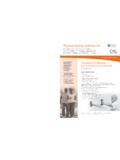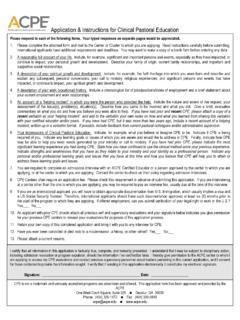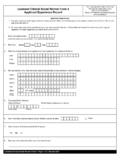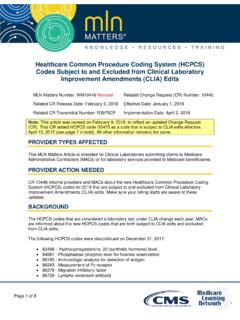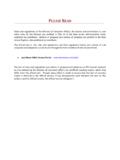Transcription of Insulin Pen Start Checklist Help Sheet - Diabetes Canada
1 Insulin Pen Start Checklist help Sheet TopicComments1. Cognitive AssessmentPrescribers need to ensure their patients/caregivers are competent to administer Insulin safely. A good screening tool to test for dementia is the clock face .12. Insulin Delivery DeviceInsulin pen type to match Insulin brand ordered. loadingPlease refer to the pen manufacturer s instruction sheets. appropriate mixing NPH and premixed insulins. Roll 10 times tip 10 times and visually check that Insulin has a consistent milky appearance. priming shotA priming shot is required when changing a cartridge or using a new needle. Typically, it is recommended to use 2 units to prime the pen, however, please refer to the pen instruction sheets from the manufacturer.
2 Dialing up doseDial-up units of Insulin required. delivery of insulinInject Insulin at a 90 angle in desired injection site when using a shorter needle (4, 5 or 6 mm). A 45 angle may be needed if the person is thin or if a longer needle ( 8 mm) is being used. A proper skin lift should also be used in thin individuals or when using longer needles. Hold the injection for 10 seconds to ensure full delivery of dose. 3. Insulin (When available, use pre-printed Insulin orders. Reference Insulin product monograph.)Timing of injectionTypeOnset ( How quickly it starts working)Onset ( When it is most effective)Duration ( How long it works)Timing of injection ( When should it be given)Bolus insulinsRapid acting analogues Apidra / Humalog / NovoRapid10 15 min1 2 hours3 5 hoursMay be given with 1 or more meals per day.
3 To be given 0 15 minutes before or after Humulin-R / Toronto30 min2 3 hoursMay be given with 1 or more meals per day. Should be injected 30 45 minutes before the Start of the insulinsIntermediate-acting Humulin-N / NPH1 3 hours 5 8 hours up to 18 hoursOften started once daily at bedtime. May be given once or twice daily. Not given at any time specific to analogues Lantus Levemir90 minnot applicableup to 24 hours16 24 hoursOften started once daily at bedtime. Insulin detemir (Levemir) may be given once or twice daily. Not given at any time specific to mealsPremixed insulinsPremixed regular Insulin Humulin 30/70 / Novolin ge 30/70, 40/60, 50/50 Varies according to types of insulincontains a fixed ratio of Insulin (% of rapid-acting or short-acting Insulin to % of intermediate-acting Insulin ): see above for information about peak actions based on Insulin containedMay be given with one or more meals per day.
4 Should be injected 30 45 minutes before or after Insulin analogues NovoMix 30 / Huma-log Mix 25, Mix 50 Varies according to types of insulinMay be given with one or more meals per day. Should be injected 0 15 minutes before the Start of the meal. injection sitesAbdominal injection site has the most consistent rate of absorption. Arm injection site is difficult to self-inject. Absorption from the buttock and thighs is more likely to be affected by exercise. Avoid intramuscular injection as this can affect Insulin absorption and cause high or low blood glucose levels. Follow a site rotation pattern. Avoid a 2-inch area around the belly button as well as all scar tissue.
5 Selection of needle lengthSelection should be based on patient preference, increased BMI does not increase skin thickness. Shorter needles, , 5 or 6 mm should be offered. 8 mm needles may increase the comfort of injection for some, especially with large Insulin doses. 12 mm needles should not be recommended. storage/expiryUnopened Insulin should be stored in the fridge between 2 C and 8 C. Opened Insulin can be stored at room temperature for up to 1 month, with the exception of Insulin detemir (Levemir) which is stable for 42 days. Keep Insulin away from direct heat and light. Discard Insulin that has been frozen or exposed to temperatures greater than 30 of injectionTypeOnset ( How quickly it starts working)Onset ( When it is most effective)Duration ( How long it works)Timing of injection ( When should it be given)TopicComments4.
6 Return demonstrationHave patient demonstrate injection; assess for correct technique and make suggestions as Hypoglycemia signs and symptomsProvide information on hypoglycemia. Taking Insulin can cause hypoglycemia, defined as a BG < Symptoms may include sweating, hunger, dizziness, vision changes, irritability, tingling, weakness and tremors. Signs of a severe low blood glucose may include confusion, uncon-sciousness or seizures. causes / preventionCauses of hypoglycemia: More physical activity than usual Taking too much medication Not eating on time Drinking alcohol Eating less than usualPrevention: Appropriate blood glucose monitoring Planning for activity Individualized blood glucose targets Adjustment of medication as necessary treatment1.
7 Eat or drink a source of fast-acting carbohydrate (15 grams): 15 g of glucose in the form of glucose tablets (preferred choice) 15 mL (3 teaspoons) or 3 packets of table sugar dissolved in water 175 mL ( cup) of juice or regular soft drink 6 LifeSavers (1 = g of carbohydrate) 15 mL (1 tablespoon) of honey (do not use for children less than 1 year old)2. Wait 15 minutes, check blood glucose. If blood sugar remains < mmol/L, treat again with another 15 g of carbohydrate. Once blood sugar is > mmol/L and the next meal is more than 1 hour away, eat a snack, including a carbohydrate and a protein source, such as a half-sandwich or cheese and crackers.
8 If a blood glucose meter is not available and a low blood sugar is suspected, treat anyway. Diabetes identificationRecommend wearing a MedicAlert bracelet. May also purchase medical identification bracelets at drug and jewelry stores. Recommend patient carries information in their wallet about their Glucose ChecksRecommend a monitoring Sharps DisposalCheck local pharmacy for disposal of sharps regulations. Most pharmacies supply safe puncture-proof containers. When the container is full, some pharmacies have an exchange program for proper SnacksFor HS Snacks: Usually not necessary when using Lantus or Levemir if HS BG > mmol/L, although patients may feel uncomfortable taking Insulin and not snacking, especially if past history of hypoglycemia.
9 Avoiding snacks, if possible, is good weight management strategy. TopicCommentsAcross the country, the Canadian Diabetes Association is leading the fight against Diabetes by helping people with Diabetes live healthy lives while we work to find a cure. Our community-based network of supporters help us provide education and services to people living with Diabetes , advocate for our cause, break ground towards a cure and translate research into practical | 1-800-BANTING (226-8464)114031 08/12 Q5C9. DrivingPrevention of hypoglycemia for all Insulin -treated drivers 1. Fitness of persons with Diabetes to drive must be assessed on a case-by-case Drivers should measure their BG level immediately before and at least every 4 hours (more often in cases of hypoglycemia unawareness) during long drives.
10 They should always carry BG monitoring equipment and supplies of rapidly absorbable carbohydrate within easy reach ( attached to the visor).3. Persons should not drive when their BG level is < mmol/L. They should not begin to drive without prophylactic carbohydrate treatment when their BG level is in the mmol/L Drivers should stop and treat themselves as soon as hypoglycemia and/or impaired driving is suspected. Persons should not drive until at least 45 60 minutes after effective treatment of mild to moderate hypoglycemia (BG level mmol/L).Prevention of hypoglycemia for Insulin -treated commercial driversBG level must be tested within 1 hour before driving and approximately every 4 hours while driving.



